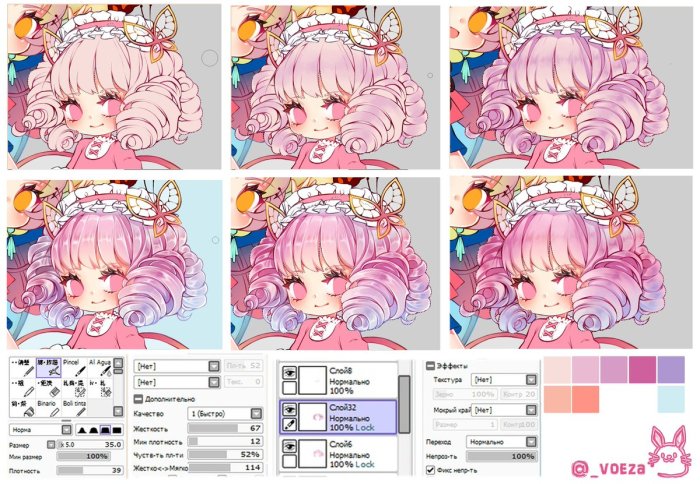Popular Anime Hair Coloring Techniques in Photoshop

Anime hair coloring photoshop – Achieving vibrant and dynamic anime hair in Photoshop requires a nuanced understanding of color manipulation, blending modes, and digital painting techniques. This section will explore several key methods for creating realistic and stylized anime hair, focusing on practical steps and illustrative examples.
Vibrant, Saturated Anime Hair Color Using Adjustment Layers
This technique leverages Photoshop’s non-destructive adjustment layers to achieve intense, anime-style hair colors. Begin by selecting the hair layer. Add a Hue/Saturation adjustment layer (Layer > New Adjustment Layer > Hue/Saturation). Experiment with the Hue slider to shift the color, Saturation to increase vibrancy, and Lightness to adjust brightness. For a more targeted approach, use a Clipping Mask (right-click the adjustment layer and select “Create Clipping Mask”) to confine the effect only to the hair.
Further refinement can be achieved by adding a Color Balance adjustment layer, allowing fine-tuning of individual color channels (red, green, blue) for a more precise color. For example, increasing the red and yellow channels might create a warmer, more golden hue. Conversely, boosting the blue and cyan channels could create a cooler, more icy effect.
Blending Modes for Realistic Highlights and Shadows
Blending modes offer a powerful way to integrate highlights and shadows seamlessly into the hair. After establishing a base color, create a new layer for highlights. Use a soft brush with a low opacity to paint highlights in a lighter shade of the base color. Experiment with blending modes like “Overlay” or “Soft Light” to blend the highlights naturally with the base color.
These modes enhance the luminosity of the underlying color without drastically changing the hue. For shadows, create another new layer and use a darker shade of the base color. The “Multiply” blending mode is ideal for shadows, darkening the base color without losing detail. Vary the opacity and brush size to control the intensity and softness of both highlights and shadows.
Mastering anime hair coloring in Photoshop often involves experimenting with vibrant hues and unique shading techniques. For inspiration, exploring pre-existing artwork can be beneficial, such as the detailed character designs found in anime coloring pages Yuri on Ice , which showcase a wide range of hair colors and styles. Observing these examples can inform your own digital painting process and help you achieve similar effects in your Photoshop projects.
Consider using a layer mask to refine the edges of the highlights and shadows for a more natural appearance. For instance, a subtle highlight along the top edge of a strand, using the “Overlay” mode at 30% opacity, can create a believable shine.
Comparison of Tools for Smooth Gradients and Color Transitions, Anime hair coloring photoshop
Photoshop offers several tools for creating smooth gradients and color transitions in anime hair. The Gradient Tool provides a straightforward method for creating linear, radial, or other gradient types. However, for more organic transitions, the Brush Tool with a low opacity and careful blending offers superior control. For complex transitions, the Smudge Tool can be used to blend colors and soften edges.
The choice of tool depends on the desired level of control and the complexity of the gradient. For example, the Gradient Tool is efficient for creating a simple highlight across a large area, whereas the Brush Tool is better suited for painting subtle, nuanced highlights and shadows within individual strands. Mastering all three offers flexibility in achieving diverse effects.
Step-by-Step Tutorial: Painting Realistic Anime Hair Strands
This tutorial focuses on using custom brushes to paint individual strands of hair. First, create a new layer. Import or create a custom brush with a slightly textured, tapered tip, mimicking the shape of a single hair strand. Using a low opacity and varying pressure, paint individual strands, following the overall flow and direction of the hair.
Pay attention to the way light interacts with the hair, adding highlights and shadows accordingly. For example, strands closer to the light source receive more intense highlights, while strands farther away are darker. Layer the strands to create depth and volume. Vary the brush size and opacity to create thin, wispy strands as well as thicker, more substantial ones.
Using a darker shade, paint subtle shadows where strands overlap to create dimension. Finally, use the Smudge Tool with low opacity and a small brush size to gently blend the strands together and soften any harsh lines. This process allows for building realistic-looking hair with individual strands.
Illustrative Examples of Anime Hair Coloring in Photoshop
This section delves into practical examples of anime hair coloring techniques in Photoshop, showcasing the versatility and artistry achievable through different approaches. We will explore various styles and the specific techniques used to create them, providing a detailed understanding of the process.
| Style | Description | Techniques | Example Image Description |
|---|---|---|---|
| Pastel | Soft, muted tones, often featuring light, airy colors. | Utilizes soft light blending modes to achieve a gentle, diffused effect. Low saturation keeps the colors delicate and prevents harshness. Careful use of highlights and shadows adds depth without overpowering the pastel palette. | Imagine a character with hair the color of a cotton candy sunset—soft pinks and blues blend seamlessly, with subtle, almost imperceptible highlights that give the hair a luminous quality. The overall effect is dreamy and ethereal. |
| Vibrant | Bold, saturated colors, characterized by high contrast and striking hues. | Employs overlay blending modes to intensify the colors and create a powerful visual impact. High saturation ensures the colors are rich and intense. Sharp highlights and shadows add definition and texture. | Picture hair like a blazing inferno—bright, saturated reds and yellows create a dynamic visual. The highlights are crisp and defined, almost glowing, contrasting sharply with deep, rich shadows that add depth and dimension. The overall impression is energetic and dramatic. |
| Realistic | Aims for a natural appearance, mimicking the nuances of real hair. | Relies heavily on adjustment layers for color correction and subtle enhancements. Careful shading and highlighting are crucial to achieving realism. Techniques like using a variety of blending modes for subtle color variations and detailed shadow work are key. | Envision dark brown hair, rendered with a high degree of realism. Subtle highlights create the illusion of light reflecting off individual strands, while carefully placed shadows give the hair volume and depth. The overall effect is natural and believable. |
| Stylized | Unique and often exaggerated color palettes, defying realism for artistic expression. | Often involves the use of custom brushes to create unique textures and effects. Experimental blending modes and color combinations are employed to achieve an unconventional look. This style often features bold, unexpected color choices and textures that break away from traditional representations. | Imagine hair with an otherworldly quality—bright, unnatural greens and purples swirl together, creating a visually striking effect. The texture is unconventional, perhaps incorporating streaks of vibrant color or unusual patterns. The overall impression is imaginative and expressive. |
Detailed Descriptions of Anime Hair Styles
This section provides detailed descriptions of three distinct anime hair styles, illustrating the color palettes and techniques involved in their creation.
Style 1: Oceanic Dream
This style features a captivating blend of teal, turquoise, and deep blues, reminiscent of an ocean’s depths. The techniques employed include a combination of soft light and overlay blending modes to create a shimmering, almost iridescent effect. Subtle highlights of a lighter teal are carefully placed to mimic the way light reflects off water. Darker blues are used to create depth and shadow, enhancing the three-dimensional quality of the hair.
The overall effect is serene and visually stunning.
Style 2: Fiery Sunset
This style showcases a vibrant palette of oranges, reds, and yellows, evoking the warmth and intensity of a sunset. The techniques used involve a heavy reliance on the overlay blending mode to amplify the saturation and create a radiant glow. Sharp highlights of bright yellow and orange are strategically placed to simulate the fiery intensity of the sun’s rays.
Deep reds and oranges are used in the shadows to add depth and contrast, enhancing the overall dramatic effect. The result is a bold and dynamic look.
Style 3: Silver Moonlit Night
This style uses a cool palette dominated by various shades of gray, silver, and white, creating a mystical and ethereal atmosphere. The techniques involve careful use of adjustment layers to achieve the precise shades of gray and silver. Subtle highlights of a brighter silver are applied to simulate the reflection of moonlight. Darker grays are used to create depth and shadow, adding a sense of volume and texture.
The overall effect is elegant and mysterious.
Troubleshooting Common Issues in Anime Hair Coloring: Anime Hair Coloring Photoshop

Anime hair coloring in Photoshop, while creatively rewarding, often presents unique challenges. Achieving that signature vibrant, yet natural-looking style requires careful attention to detail and a solid understanding of Photoshop’s tools and techniques. This section addresses common pitfalls and provides solutions for achieving polished results.
Uneven Color Distribution and Unnatural Highlights
Uneven color distribution can significantly detract from the overall quality of your anime hair coloring. This often stems from using the wrong tools or applying color without sufficient blending. Unnatural highlights, conversely, can appear jarring and unrealistic. They frequently arise from applying highlights too harshly or without considering the light source. Addressing these issues involves careful layer management and the strategic use of blending modes.
For instance, using a soft brush with low opacity for color application ensures gradual transitions and prevents harsh lines. Subtle highlights can be achieved by using the Overlay or Soft Light blending modes on a separate layer, allowing for adjustments without altering the base color.
Effective Use of Layers and Blending Modes for Correction
Layers are fundamental to successful digital painting. In anime hair coloring, they enable non-destructive editing, allowing for corrections and refinements without impacting previous work. Each color, highlight, or shadow should ideally reside on its own layer. This modular approach simplifies adjustments and facilitates experimentation. Blending modes offer further control.
For example, using the “Multiply” blending mode darkens the underlying layers, creating realistic shadows, while “Screen” brightens, enhancing highlights. Experimentation with these modes, combined with opacity adjustments, provides a vast range of effects. If a mistake is made, simply reduce the layer’s opacity or erase parts of it. The original color remains intact on the layer below.
Achieving Smooth Transitions Between Colors and Shades
Smooth color transitions are crucial for creating believable and visually appealing anime hair. Harsh lines between colors disrupt the realism. Several techniques help achieve smooth gradients. The Gradient Tool offers a direct way to blend colors smoothly, while the Smudge Tool can soften hard edges and create subtle variations. Using a low-opacity brush to blend colors manually is another effective method.
Remember to work on separate layers for each color, allowing for finer control and easier correction. Pay attention to the direction of the hair strands to ensure a natural flow of color.
Tips and Tricks for Avoiding Common Pitfalls
A well-organized workflow is key to avoiding common mistakes.
- Always start with a clean sketch and base color on a separate layer.
- Use multiple layers for highlights and shadows, allowing for individual adjustments.
- Experiment with different blending modes to achieve desired effects.
- Utilize masking techniques for precise control over color application.
- Regularly zoom in to check for detail and smoothness.
- Save your work frequently to avoid losing progress.
- Reference real-world hair and lighting for inspiration.
These simple steps will drastically improve the overall quality and efficiency of your anime hair coloring process.

